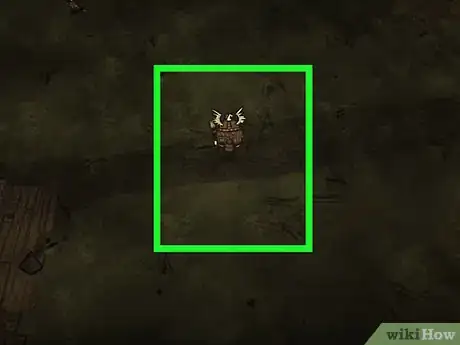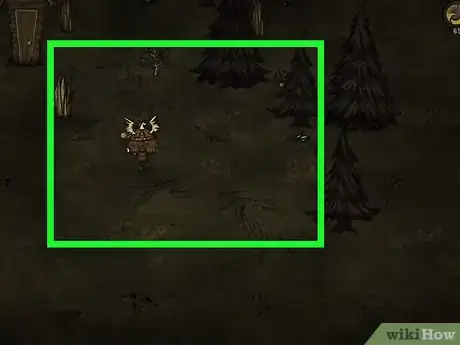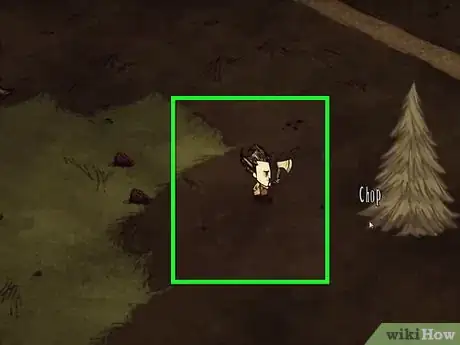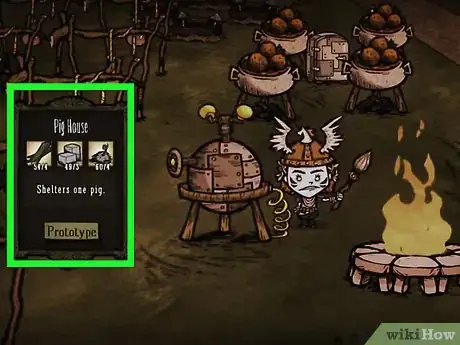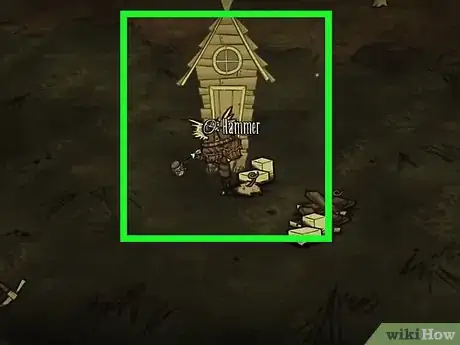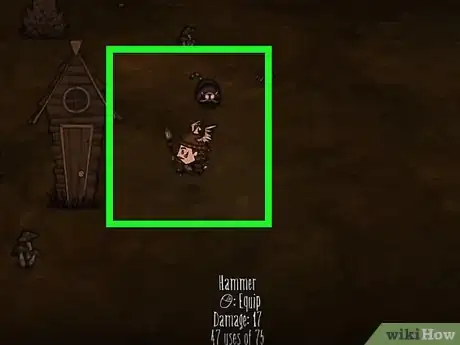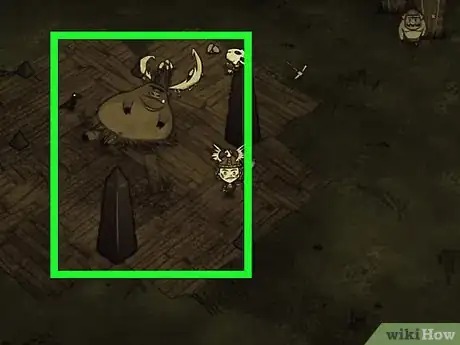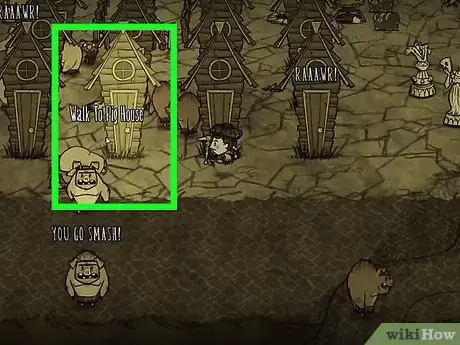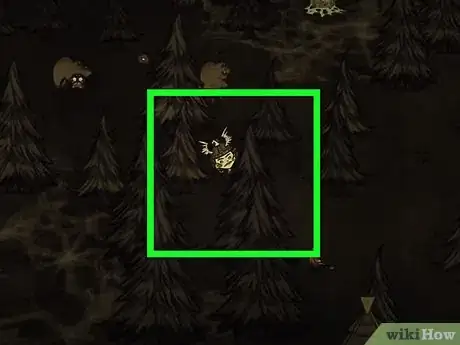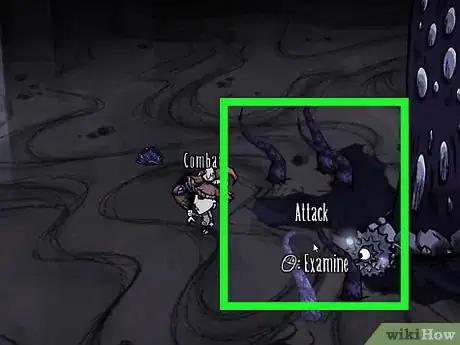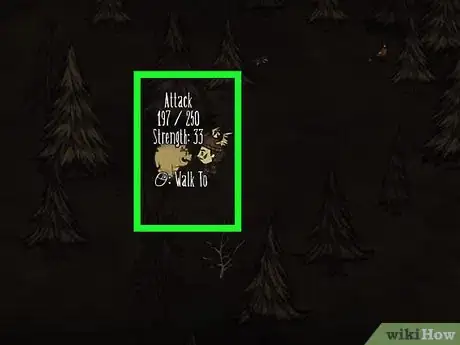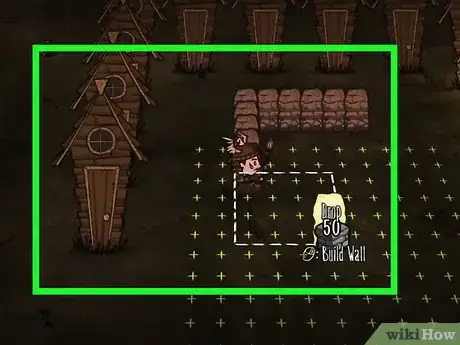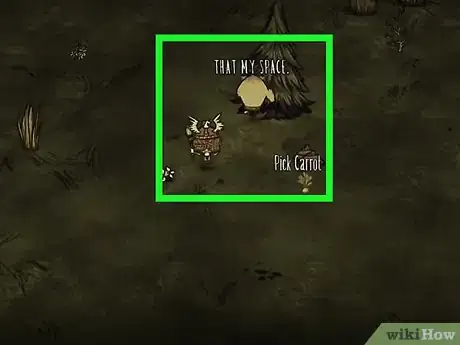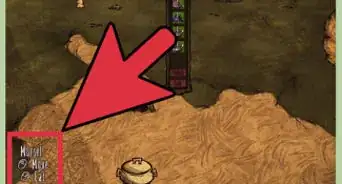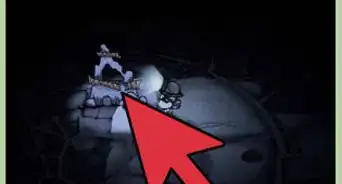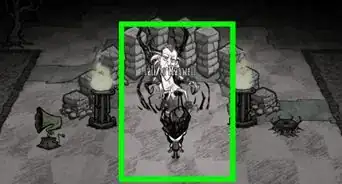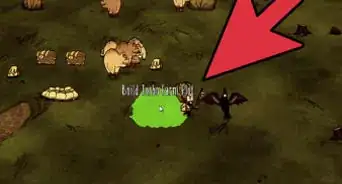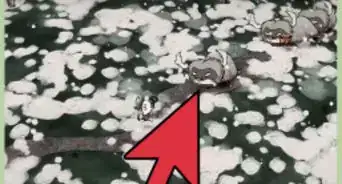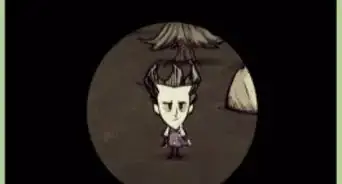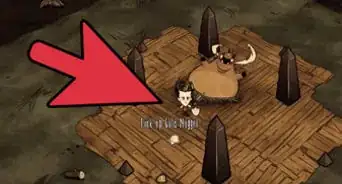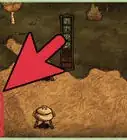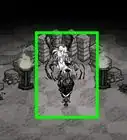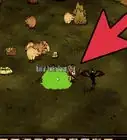wikiHow is a “wiki,” similar to Wikipedia, which means that many of our articles are co-written by multiple authors. To create this article, volunteer authors worked to edit and improve it over time.
This article has been viewed 48,517 times.
Learn more...
In Don’t Starve, you may get get tired of scavenging for food without any reliable way to feed yourself. It’s understandable, since the game is constantly hurling monsters at you. The best way to get around this is via farming. The term isn’t just referring to planting things to grow food, but the gaming term for “harvesting” resources with minimum effort. However, farming isn’t enough sometimes, especially when you run out of the things and creatures you get your resources from. Fortunately, the game has quite a lot of renewable resources for you.
Steps
Considering the Necessities
-
1Consider your resources. Some of the early game resources, especially Seeds, Grass, Berries, Mushrooms, and Rabbits, are easily renewable without difficulty. Bigger, more substantial and important resources (like Meat, Pig Skins, Silk, and Beefalo fur) can be a bit more difficult to farm, but are definitely worth it. Some are only available in certain places, like Monster Meat, Gems Cave Bananas, Tentacle Spikes, Fish, and Frog Legs. So before everything else, consider what you want to farm or what you consider to be most important to farm, since this will determine where your base camp will be.
- At most, a few “food” structures, some way to get manure, and some other surface resources (like Saplings and Grass Tufts) would be enough to ensure your continued, self-sustaining survival for several weeks at a time, even in Winter. More advanced builds include sustainable farming in rarer or more uncommon in hazardous places, such as Marshes, Caves and Ruins, and it’s only advisable if the player prepares themselves to farm there with a clear safety net in close reach, like a Touch Stone or a Meat Effigy.
-
2Check if it’s renewable or not. Before getting hyped up to make a sprawling, complicated farm, consider first if your materials are easily renewable at this point.
- For example, Bees and Honey are infinitely renewable as long as there’s a Hive or a Bee Box, but Honeycomb, which you get from destroying Bee Hives, are not.
- You can dig up Saplings, Berry Bushes, and Grass Tufts and replant them, but while their resources are renewable every 4 days, the objects themselves are not.
- Gold is infinitely renewable if you go down the Caverns and wait for an Earthquake, or find a Pig King to give Meat to, but most Gravedigger items, like Gnomes, Gears, and Hardened Rubber Bungs are not renewable.
- The only renewable items you get from digging up Graves are Gems, Life Giving Amulets, and Nightmare Fuel, since they can be found and made elsewhere. Checking the Wiki for the complete list is advisable for the new or unsure players, but generally speaking, if it’s a treasure, or if you can’t plant it or raise it, you usually can’t renew it.
- Thulecite and Gems (Green, Yellow, or Orange) are very rare resources in the Ruins and aren’t reliably renewed. However, in Reign of Giants, they have a chance to be found in Tumbleweeds, making them renewable. Same with the most Gravedigger items and Fireflies.
Advertisement -
3Scout a good area. The best area to camp in is a Grasslands with all the other biomes within a few seconds to a minute away from you. This will give you a wide area to place your base in, and the Grasslands also provide you with some easy resources you can relocate to your camp with a Shovel. If not, look for places with a concentration of your prefered resources. For example, if you want to farm Fish and Frog Legs, scout out a Grassland area full of Ponds. If you want to farm Beefalo for their fur, Meat, and Manure, check out a Savannah full of them.
- If you make a camp between multiple Biomes, make sure you scout out the others first. It would do you no good if you camp beside a Savannah with no Beefalo if you plan on farming them.
- If you can find a Worm Hole leading to some further places with plenty of resources, by all means make camps near them. Just remember that traveling through them costs some Sanity in return.
-
4Make some tools. Of course, tools don’t just mean an Axe, Pickaxe, and Shovel. You’ll also need a Shovel to relocate Grass Tufts, Berry Bushes, and Saplings, or to dig out tree stumps to make room for your stuff. Hammers are also useful to break down natural structures you can find in the world to gather more resources. However, those aren’t the only tools you can use for survival.
- You’ll be needing plenty of Traps to farm Rabbits, Frogs, and Spiders, for example. Bird Traps are exclusively for farming Birds for their Feathers and Morsels, or to raise as your main source of Eggs and Crop Seeds. And, of course, you’ll need Tooth Traps, weaponry, and armor to farm some of the bigger animals and ward off the periodic Hound attacks.
- You’ll also be needing more advanced crafting stations for some of the more unusual and useful objects. An Alchemy Engine is the minimum requirement for your major crafting needs, especially in the next section.
-
5Consider your structures. Now, it’s time to get into the structures you can build! There’s quite a lot of things you can make under the Food tabs and Structures tabs, and most of them are vital for survival. Some of them can be a bit expensive, some of them cheap, but all of them are useful as long as you know how to use them.
- Farm Plots are the easiest to make, requiring 6 Cut Grass, 4 Logs, and 4 Manure for the Basic model, and 10 Cut Grass, 4 Rocks, and 6 Manure for the Advanced model.
- If you can’t find a lot of naturally-spawning Pigs nearby, you can make your own Pig House. It costs 4 Boards, 3 Cut Stone, and 4 Pig Skin. (Pig Skin usually requires you to kill some Pigs, but if you can find a Touch Stone anywhere or some Merm houses in a Marsh, you can just hammer the Pig Heads to gather the Skins.)
- Making a Bird Cage is a bit expensive, at 2 Papyrus, 6 Gold, and 2 Seeds, but the yield from trapping a bird in it is worth it.
- Bee Boxes may be tricky; aside from 2 Boards, you have to destroy a Bee Hive to get the necessary Honeycomb and capture 4 Bees, but the yield is low-risk and high-return.
- There’s a lot more structures you can make that can help your survival, but for your farming needs, these are the most important, since they are highly renewable and definitely profitable even early on in the game!
-
6Protect your farm. There are several structures that can help you prevent damage to your farm.
- Craft a Lightning Rod and place it near important structures. This will prevent any freak lightning strikes from burning your farm to sad, expensive ashes.
- Placing Stone Walls and Tooth Traps around most of your structures is heavily advised as well, in case of Hound attacks. The exceptions are Pig Houses, since they can fight back and tend to trigger the Tooth Traps.
Building and Using Your Farms
-
1Know the types of farms. There’s many ways to continuously farm your resources, especially if you’re clever enough. The main types will be outlined here, with some methods in farming certain resources. The guide won’t delve into all of the resources that you can farm, but will show some resources and the methods to farm them, mainly the Surface resources.
-
2Care for your plots. This method mainly involves the Farm Plots you made, and the Saplings, Berry Bushes and Grass Tufts you dug up. This method is completely static, with the lowest level of interference from the player. When you plant the seeds into the Farm Plots, you can either wait to get your food, which will take about a day or so, or if you’re the impatient type, you can just fertilize it continuously until a fresh crop pops up. To fertilize them, you need Manure or Rot. To get Rot, just leave out some food; to get Manure, hand out some non-meat food to Pigs so they’ll poop themselves, or follow some Beefalo around until they poop themselves.
- Reeds, a Marsh-exclusive resource, can’t be dug up and relocated like Grass Tufts, since it destroys the tuft that grows the Reeds. You can’t dig up Rabbit Holes or Mushrooms up either for the same reasons. Which means you manually have to gather them yourself.
- When you place Grass Tufts and Berry Bushes on the ground, you’ll also need to fertilize them before they can start growing their resources. Just 1 unit of any fertilizer will do. Saplings don’t need to be fertilized, and they all renew their respective resources every 4 days.
- For maximum efficiency, group your crops together in different areas, and place Lightning Rods in the middle of each crop farm. This is because these kinds of farm are highly flammable, and one stray lightning bolt is enough to burn everything down.
-
3Keep an eye on your traps. One of the first objects you can craft is the humble Trap, which has a very cheap cost, easily renewable, and has quite a lot of uses. Spiders, Rabbits, and Frogs are susceptible to getting caught under Traps, and picking up rustling Traps would yield you goodies to eat, and in the Spiders’ case, make Silk and Spider Glands renewable with the least amount of effort. For the Rabbits, placing a Trap directly above the Rabbit Hole is the best way to catch them. For Spiders and Frogs, place the Traps around the Spider Den or the Pond. You’ll need to check on the Traps for the Frogs and the Rabbits at around Dusk, while checking for the Spiders are best left for morning. This is because Frogs and Rabbits spawn during daytime, while Spiders roam around at Night.
- Remember not to step on the “webbing” surrounding Spider Dens unless you want to purposely attract Spiders towards you and the trap.
- Bird Traps are best left alone with a single Seed in them, but must be checked every few minutes, since they also spawn during dusk. Crows are more common in the Rockylands all year round, while Grasslands find itself with more Redbirds, which are found in the Summer, and Snowbirds, which are found in Winter.
- You’ll be better off saving one bird to keep in the Bird Cage. This is so you can have a renewable source of Eggs and Crop Seeds. Eggs are useful for recipes, feeding Pigs, or trading with the Pig King, while Crop Seeds are useful if you wish to farm specific Fruits or Vegetables, like Dragon Fruits or Pumpkins. To get eggs, you can feed the bird most kinds of meat, excluding raw Monster Meat. To get Crop Seeds, feed it a specific crop you want, excluding Berries, Mandrakes, Lichen, Cave Bananas, or Mushrooms, and it will drop 1 or 2 seeds of that crop.
- You can feed it any of the above foods in any level of spoilage to constantly recycle and renew your food sources. You can also feed the bird any Seeds in any state of freshness to get fresher Seeds.
-
4“Breed” your resources. Some resources, like Trees, Pigs, Spiders, and Beefalo, tend to multiply and spread when you get the conditions right, or when you use their farmed resources to create more of them. This is basically called the “Breeding” method, and while all of them aren’t naturally self-replicating, the resources are highly and easily renewable with only the occasional interference on your part.
- Trees are the easiest to “breed” and farm out of all these resources. All you need is a Pinecone, a Shovel, and an Axe. Whenever you fell a tree with your Axe, the tree will drop a Pinecone (two, if you chop a full grown one). You can then plant the Pinecone(s) in a nearby, cleared area, then wait about a full game day for it to grow into a small tree. Wait about another day for it to spawn a medium tree, or a few more days for it to become a full grown tree.
- Pig Houses spawn a single pig at a time, and if that one is killed, another one takes his place four days after he’s killed. This means you can keep killing that Pig for Meat and Pig Skin, ensuring that you can build another Pig House and increase your Pigs. With this method, you can probably make your own Pig Village in a few weeks’ time. In RoG, you need to keep your Pigs away from your base camp. This is because during the full moon, the Pigs may turn into Werepigs, which can wreak havoc on you and your resources, so keeping them near but away from your camp or other farms is a must.
- Beefalo have “mating seasons” where they grow aggressive for a few days and spawn a few Baby Beefalo at the end, making their Meat, Beefalo Wool, and Manure infinitely renewable, as long as at least 2 Beefalo remain before every mating season. You can lure them into a “pen” made out of Walls and Savannah Turf by using a Beefalo Horn, which you can get from killing Beefalo. Don’t kill the Beefalo while they’re near any others, since they attack as a herd. Set up some Tooth Traps in the pen to automatically cull the herd occasionally.
- If you want a more controlled way to farm Spiders, fully grown Spider Dens can be torn down to yield several silk and spider eggs. Sometimes, they will also spawn a Spider Queen whenever you walk into the webbing, and she spawns a smaller Spider Den and several Spiders in turn while trying her best to maim you. If you slay her, you get a set of Spider Eggs, which you can place down to spawn a single Den, or you can leave her alone for a few minutes, and she’ll settle back down as a small Spider Den in an area away from any other Dens. The third method lets you “breed” more Dens with minimum risk, but the second method lets you place your Den wherever you want, as well as acquire a rare item, the Spider Hat, which lets you interact with Spiders with minimum risk. Most players tend to use the first method to not have to depend on RNG and combat skills.
- If you have a Berry farm and want to farm Gobblers as well, place some Tooth Traps inside the Berry farm so that when one spawns, it is messily murdered and you are free to take its delicious, meaty corpse for your dinner. They’re available in the original edition and RoG and have a low spawn rate, since they spawn whenever you pick Berries. Be careful though, since even one spawning will definitely ruin your Berry farm, as it just keep eating every Berry it sees in a single screen before wandering off. It will also attack any crop food you leave on the ground, meaning you can lure it with a carrot or a single berry towards the tooth traps if you don’t mind some of your Berries being eaten.
- Bee Boxes also count as a “breeding” method, since it respawns a Bee every 2 minutes whenever one from the box is killed, for a maximum of 4 Bees per Box. The box itself starts to get visibly covered in honey whenever it’s almost full, and you can harvest it for a maximum of 6 Honey. To minimize damage from Bees, craft a Beekeeper’s Hat. This will reduce the damage taken by a whopping 80%.
-
5Go hunting. Some resources are utterly hostile or uncontrollable, but respawn dependably. Nearly every hostile enemy can be farmed reliably, but it’s normally really risky. Luring them into Tooth Traps or nearby Pigs, Beefalo, or Tentacles will help tremendously, as long as you're quick when gathering your spoils. But here are some general guides on how to beat them if you’re low on resources or don’t have those available around you.
- If you found a Plugged Sinkhole, you can go down or wait for dusk for Batsilisks to appear. In the Caverns, they spawn everywhere, but on the surface, they will spawn from the Sinkhole every dusk and occasionally drop Guano, which is the best fertilizer in the game. Killing them will yield you Batsilisk Wings and some Monster Meat as well, and can be killed with most weapons and Tooth Traps with one or two hits.
- The Tallbirds that live in the Rockylands are viciously tough and can usually kill you in 2 hits. But they’re easy to beat of you hit them once, run away, then hit them again. They respawn about a day and a half, as long as their nests in the Rockylands remain untouched and undamaged.
- Occasionally, you can find Suspicious Piles of Dirt on the ground, and unearthing it will yield a footprint. Following it will lead you to another pile to unearth and reveal another print, and you need to repeat this until you find your quarry: the Koalefant. You can chase it into a pen if you desire a pet, since it occasionally drops Manure, but it’s much better if you kill it, since it would drop a considerable amount of Meat and a Koalefant Trunk. While it’s inclined to fight back if you attack it, it’s less risky to hunt it down than some of the other creatures.
- In RoG, the risk increases exponentially with the introduction of the Varg. It has a low chance to spawn instead of Koalefants if you track down the footprints and calls for Hound reinforcements the longer you take to kill him. He yields about 6 Monster Meat and 1-3 Hound Teeth upon death, not counting the possible spoils when killing his cohorts.
- Hounds spawn every few days to maim the player and make their life miserable, and with their speed, ability to spawn wherever you are when the time comes, and the fact that they love to hunt in groups, it can be difficult to kill them without help. What you can do is make a structure called a “panic room,” which is a three-wall thick room or corridor with Bee Mines, and eventually, Tooth Traps lined in and around it to thin the pack and leave you the weakened stragglers, and then run there when you start hearing barking and growling. You can probably fight them off the first few “months” of the game, but the longer you play, the more of them hunt you down whenever they arrive.
-
6Exploit “natural” resources and biomes. Ponds, Tentacles, Pig Kings, even the random animals you find in the world can also be used to farm resources. They all have different gimmicks, but with them around, you can renew quite a lot of your resources just by knowing how to deal with them.
- If you’re lucky enough, you may be able to find a Pig King when exploring the world. He’ll trade you Gold Nuggets for Gravedigger Items and Meat (excluding monster meat and its byproducts) items, so if you have a reliable way to farm meat, you can use him to constantly renew your stock of Gold. It’s better if you use Morsels and Eggs rather than Meat, since they’re all worth the same amount of Gold to the Pig King, but Meat is more useful to the player. If you can easily access the Ruins and a Ruins Pond, you can just fish out several Eel, cook them, and bring them to the Pig King. For the player, Eel are functionally identical to the regular Fish they can get from normal Ponds, but it’s worth 4 Gold to the Pig King.
- If you find a nearby Marsh, you can also probably spot some Rundown Shacks, Tentacles, and Merms. What you can do is pit them against each other by luring the Merm towards a spot that’s bubbling, then watch as the Merm and the Tentacle duel it out until one dies! Then when one dies, pick the item up quickly and repeat the process! This will net you quite a lot of Fish, Frog Legs, and even Tentacle Spots and Tentacle Spikes when the Tentacle finally dies! This isn’t infinitely renewable though, but it’s a great way to get a lot of resources quickly!
- If you venture into the Caverns, you’ll periodically experience Earthquakes shaking the place up. This will drop quite a lot of mineral items (rocks, gems, flint, etc.) on the ground, and Rabbits and Moleworms in RoG. Just make sure to dodge the falling items, since they can damage you. This also ensures a lot of materials to be infinitely, if somewhat unreliably, renewable. You can trigger earthquakes by igniting Gunpowder, Slurtle Slime, Slurtle Mounds, Slurtle, and Snurtle using a Telelocator Staff or the RoG-only item Old Bell, or by beating a Big Tentacle.
- In the Caverns, you’ll sometimes see a ridiculously huge Tentacle reaching towards the Surface, officially called a Big Tentacle. Players affectionately refer to it as the Tentapillar, and beating one of them makes them retreat into their holes instead of dying, making Tentacle Spikes, Light Bulbs, and Tentacle Spots renewable. The Tentapillar spawns smaller Tentacles, called Baby Tentacles, to protect it, but those are ridiculously weak and take 1 hit from most weapons before dying.
- This is an RoG-only method, but is useful for the player too unprepared to dive in the caves for minerals. Simply dig up any Moleworm Holes, which are visually larger and “messier” than Rabbit Holes, and it will yield you some amount of rocks, flint, nitre, and occasionally gold. This is infinitely renewable, since Moleworms tend to just spawn new holes whenever they can’t find a nearby one.
- You can also catch Moleworms by laying down a Rock or a Flint, then whacking them on the head with a Hammer when they emerge. Then you can pick up the materials, dig up the hole they made, set them free, and lure them again!
- Another RoG-only method that makes renewing some unusual items easily is by constantly feeding or giving “gifts” to nearby Catcoons. Catcoons will eat “small” meat items like morsels, fish and eggs, and you can give them easily acquired items like cut grass, twigs and pinecones to befriend them. In return, after a while, they’ll barf up other items, like Crop Seeds, Petals, and even Tumbleweeds. Catcoons also tend to attack Butterflies and Birds, so setting down a lot of Flowers and some Seeds in an enclosed area with a Hollow Stump in it would ensure a quick and easy way to farm Butter, Butterfly Wings, Feathers, and Morsels—if you’re quick enough to gather them before the Catcoon takes them for itself.
Maintaining Your Farms
-
1Schedule your harvesting. Scheduling when your harvests take place is useful if you’re fond of exploring, or you can set up several farms in several places. Most farmable resources are renewed every few days, so what you can do is harvest one or two farms every day, then all you need to do is wait for your resources to renew itself. This will keep you from frantically rushing everywhere and wasting time, with huge periods of time without anything to do. This will also free up some time for exploration if you time your harvests just right.
-
2Keep farms a short distance from each other. While this is more of an organizational thing, this will help greatly in case of Hound attacks, “boss” monsters and Giants trying to wreck your place, and the occasional unlucky fire. It can also help keep mobs that heavily dislike each other from killing each other off too fast. At the minimum, structures and static farms should be about 2 spaces away from each other, and farms using living things should be about half a screen or more away.
-
3Don’t overexploit your resources. Normally, this isn’t a problem, but sometimes the frequent usage of a resource can outstrip the production of the item. Trees need to be replanted, Ponds have delay times the more you fish, and Beefalo don’t breed as often as some players think they should. Don’t be overeager when harvesting from your farm, especially when winter approaches, since a lot of resources, especially crops, grass, and twigs, stop production entirely when the cold hits. Give your farms time to recover their resources instead of killing and looting everything and having nothing left when you really need it.

